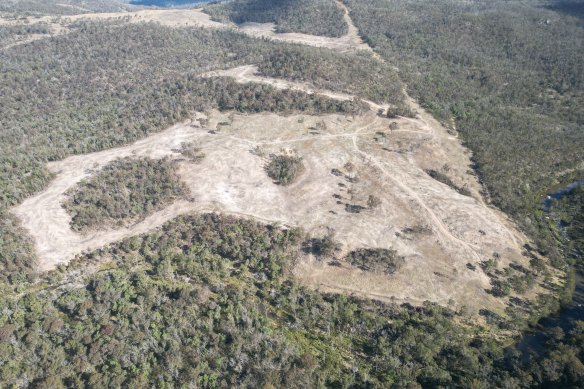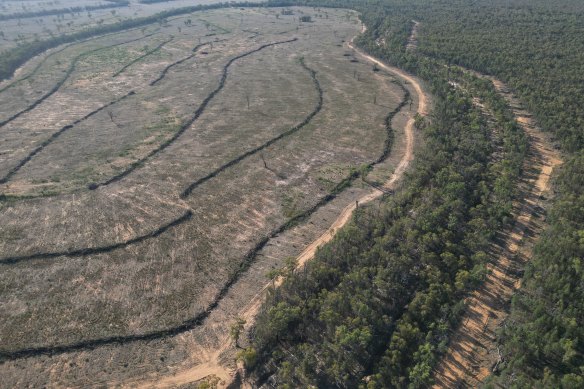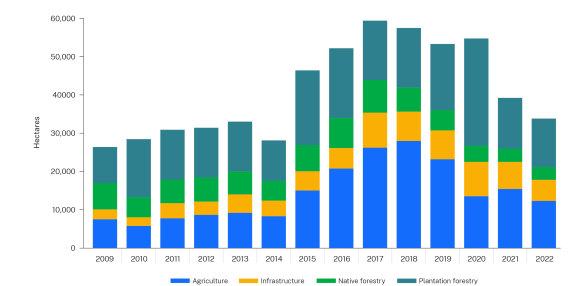- Exclusive
- Environment
- Conservation
- Farming
This was published 4 months ago
‘Lost more than half our forest’: Why NSW is a global hotspot for deforestation
NSW is a global hotspot for deforestation, with the latest government figures showing landowners cleared land equivalent to almost twice the size of the Australian Capital Territory over the five years to 2023.
The figures from the annual NSW Statewide Landcover and Tree Study (SLATS), out on Friday, show landowners cleared 420,000 hectares of native vegetation from January 2018 to December 2022.

Land clearing at Red Range in the Northern Tablelands. Image taken in 2024.Credit: Australian Conservation Foundation
More than 45,000 hectares of native vegetation were destroyed in 2022, including 21,131 hectares of woody vegetation (trees and shrubs) and 24,121 hectares of non-woody vegetation (grasslands, ferns and ground cover).
Australian Conservation Foundation campaigner Nathaniel Pelle said the current rate of forest loss in NSW was only rivalled by Queensland among the states and territories. “It’s even more concerning because of the amount of historic clearing that has already occurred in NSW,” he said.
A journal article published in Conservation Science and Practice in August 2024 found since European colonisation, 29 million hectares, or 54 per cent, of the forests and woodlands that once existed in NSW had been destroyed. A further 9 million hectares had been degraded.
In 2023, World Wide Fund for Nature ranked NSW last out of all nine states and territories for protecting and restoring trees. Victoria ranked third, while Tasmania and Queensland were seventh and eighth.
Pelle said Australia was an outlier among wealthy countries for forest loss, and the rates of land clearing were “up there” even compared with developing countries.
“Europe has been historically cleared, Canada has been historically cleared, the US and Australia have been historically cleared, but what separates us from them is that we’re still doing it,” Pelle said.
“We have already lost more than half of our forest in Australia, and that means we have a substantial amount of forest left as well, but most wealthy countries have put a stop to any ongoing clearing and are really working hard to protect and keep forest standing.”

Land clearing at Cuttabri in north-western NSW. Image taken in 2023.Credit: Australian Conservation Foundation
A 2021 global report from WWF listed Eastern Australia as a “deforestation front” along with Africa, South-East Asia and Latin America.
Pelle said land clearing meant less habitat for Australia’s threatened species, while many feral predators such as cats did better in a cleared landscape.
Protecting forests as carbon sinks is also essential to halt global warming, and Australia is a signatory to the Glasgow Leaders Declaration on Forests and Land Use, a global commitment to end deforestation and land degradation.
The SLATS figures suggest the biggest cause of the land clearing in NSW was agriculture, which accounted for 12,283 hectares. Infrastructure was next with 5509 hectares, followed by native forestry with 3339 hectares.
Land clearing in 2022 was lower than 2021, but remains higher than 2009-2014, before controversial reforms by the former Coalition government.

Land clearing in 2022 remains higher than before 2015.Credit: NSW Statewide Landcover and Tree Study
The SLATS figures suggest that 15.7 per cent of clearing of woody vegetation clearing was under the Local Land Services Act, which was amended to be more permissive to landowners in 2016.
Land clearing went up in 2015 when the former government flagged it would change land clearing laws, and spiked in 2017 after the looser laws took effect.
NSW Environment Minister Penny Sharpe said: “This report shows that land clearing in NSW remains too high. The NSW government is committed to turning this around.”
The figures since the election of the Minns government in March 2023 are unlikely to be better since the underlying legislation has not changed yet.
The 2016 legislation was opposed by Labor at the time. Sharpe and Agriculture Minister Tara Moriarty announced proposed changes in July, which are now out for consultation.
Start the day with a summary of the day’s most important and interesting stories, analysis and insights. Sign up for our Morning Edition newsletter.